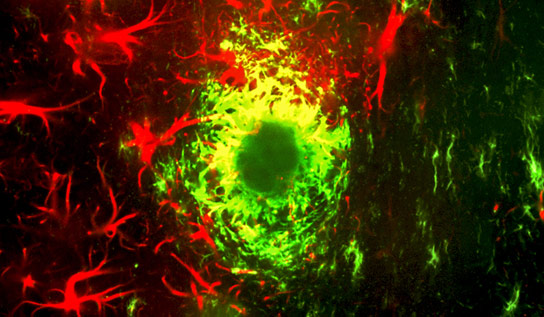
Star–like glial cells in red surround alpha beta plaques in the cortex of a mouse with a model of Alzheimer’s Disease. Credit: Yale University
New research from Yale University reveals that the experimental cancer drug AZD05030 blocks damage triggered during the formation of amyloid-beta plaques, restoring synaptic connections and memory in a mouse model of Alzheimer’s.
Memory and as well as connections between brain cells were restored in mice with a model of Alzheimer’s given an experimental cancer drug, Yale School of Medicine researchers reported in the journal Annals of Neurology.
The drug, AZD05030, developed by Astra Zeneca proved disappointing in treating solid tumors but appears to block damage triggered during the formation of amyloid-beta plaques, a hallmark of Alzheimer’s disease. The new study, funded by an innovative National Institutes of Health (NIH) program to test failed drugs on different diseases, has led to the launch of human trials to test the efficacy of AZD05030 in Alzheimer’s patients.
“With this treatment, cells under bombardment by beta-amyloid plaques show restored synaptic connections and reduced inflammation, and the animal’s memory, which was lost during the course of the disease, comes back,” said Stephen M. Strittmatter, the Vincent Coates Professor of Neurology and senior author of the study.
In the last five years, scientists have developed a more complete understanding of the complex chain of events that leads to Alzheimer’s disease. The new drug blocks one of those molecular steps, activation of the enzyme FYN, which leads to the loss of synaptic connections between brain cells. Several other steps in the disease process have the potential to be targets for new drugs, Strittmatter said.
“The speed with which this compound moved to human trials validates our New Therapeutic Uses program model and serves our mission to deliver more treatments to more patients more quickly,” said Dr. Christopher P. Austin, director of NIH’s National Center for Advancing Translational Sciences (NCATS), which funded the work.
Yale’s Christopher H. van Dyck, a co-author of the paper, and Strittmatter have initiated a multi-site clinical trial to determine whether the drug can also benefit Alzheimer’s patients. For more information on this trial being directed by van Dyck, visit https://www.adcs.org/clinical-trials or https://clinicaltrials.gov (NCT02167256 and NCT01864655).
The study was funded by the NCATS and the NIH Common Fund, through the Office of Strategic Coordination/Office of the NIH Director.
Reference: “Fyn inhibition rescues established memory and synapse loss in Alzheimer mice” by Adam C. Kaufman BS; Santiago V. Salazar BS; Laura T. Haas BS; Jinhee Yang Ph.D.; Mikhail A. Kostylev BS; Amanda T. Jeng BS; Sophie A. Robinson; Erik C. Gunther Ph.D.; Christopher H. van Dyck MD; Haakon B. Nygaard MD, Ph.D. and Stephen M. Strittmatter MD, Ph.D., 23 February 2015, Annals of Neurology.
DOI: 10.1002/ana.24394









Sounds promising! As usual, discoveries often come as side effects while searching for other solutions. Let’s hope these researchers hurry up with the multi-dimensional tests so that if it works as hoped, the drug can be marketed to all those and their families already suffering from the effects of Alzheimers today and not some time in the distant future. And if it does work, let’s also hope Astra-Zeneca doesn’t decide to make the drug too expensive for ordinary people to afford,as is already the case with too many such miracle drugs.
A good experiment which promises a cure though not fully for Alzheimerism which affects many seniors. But there is no cure to stop it at the beginning of the disease itself. At present the drugs can only delay the progression of the disease as is done in Parkinson’s disease with Levidopa drug.Already affected brain by Ameloid Plaques can be triggered to lessen their damage. One step in this angle may be good enough for a long leap in due course. Thank You.